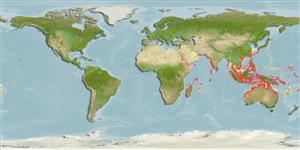Environment: milieu / Klimaatzone / Diepte / distribution range
Ecologie
marien; brak water rifbewoner; diepte 0 - 20 m (Ref. 127989). Subtropical; 32°N - 33°S, 28°E - 178°W
Indo-West Pacific: Red Sea and East Africa to southern Japan, New Guinea and Arafura Sea (Ref. 9819). Reported from Vanuatu (Ref. 13300). Migrated to the Mediterranean from the Red Sea via the Suez Canal (Ref. 5385).
Grootte / Gewicht / Leeftijd
Maturiteit: Lm ? range ? - ? cm
Max length : 30.0 cm TL mannelijk / geslacht onbekend; (Ref. 30573)
Dorsale stekels (totaal) : 12 - 13; Dorsale zachte stralen (totaal) : 8 - 11; Anale stekels: 3; Anale zachte stralen: 9 - 11. Generally silver in color, with 4-6 dark horizontal lines; a black blotch behind head and below dorsal origin and another in front of dorsal fin may be present; caudal fin pale or slightly dusky (Ref. 4327).
Body shape (shape guide): fusiform / normal.
Are coastal species often found in brackish waters; common in estuaries. They croak when taken from the water. Usually forming schools. Juveniles in seagrass beds and in mangrove bays (Ref. 48635). Feed on small fishes and invertebrates. Eggs are guarded and fanned by the male parent (Ref. 205). Maximum depth reported taken from Ref. 127989.
Levenscyclus en paargedrag
Maturiteit | Voortplanting | Paaien | Eieren | Fecunditeit | Larven
Eggs are guarded and fanned by the male parent (Ref. 205).
Paxton, J.R., D.F. Hoese, G.R. Allen and J.E. Hanley, 1989. Pisces. Petromyzontidae to Carangidae. Zoological Catalogue of Australia, Vol. 7. Australian Government Publishing Service, Canberra, 665 p. (Ref. 7300)
Status op de Rode Lijst van het IUCN (Ref. 130435: Version 2025-1)
Gevaar voor de mens
Harmless
Gebruik door de mens
Visserij: van minder commercieel belang
Tools
Speciale rapporten
Download XML
Internetbronnen
Estimates based on models
Preferred temperature (Ref.
123201): 24.4 - 29, mean 28 °C (based on 1262 cells).
Fylogenetische diversiteitsindex (Ref.
82804): PD
50 = 0.6250 [Uniqueness, from 0.5 = low to 2.0 = high].
Bayesian length-weight: a=0.01047 (0.00661 - 0.01659), b=3.02 (2.88 - 3.16), in cm total length, based on LWR estimates for this species & (Sub)family-body (Ref.
93245).
Trofisch niveau (Ref.
69278): 3.6 ±0.4 se; based on diet studies.
Weerstandsvermogen (Ref.
120179): Gemiddeld, minimale populatieverdubbelingstijd 1,4-4,4 jaar (Preliminary K or Fecundity.).
Fishing Vulnerability (Ref.
59153): Low vulnerability (20 of 100).
🛈
Climate Vulnerability (Ref.
125649): Moderate to high vulnerability (50 of 100).
🛈
Nutrients (Ref.
124155): Calcium = 34.7 [16.7, 81.9] mg/100g; Iron = 0.604 [0.350, 0.984] mg/100g; Protein = 20.1 [19.1, 21.1] %; Omega3 = 0.256 [0.154, 0.426] g/100g; Selenium = 14.2 [6.9, 26.8] μg/100g; VitaminA = 50.8 [15.9, 162.8] μg/100g; Zinc = 0.954 [0.631, 1.405] mg/100g (wet weight);
